Text: Laurent Fintoni
Header Image: Chikuma
Laurent Fintoni charts the history of the rewind from Jamaica all the way to modern dancefloors. This piece was originally published in Cuepoint in February 2015. Liner notes for the piece, including a bibliography and various other media references, can be found here.
Jamaican sound is the heartbeat of modern music. Of the many practices to emerge from sound system culture and take hold across music genres, one remains most arousing and the most maligned: the rewind.
For the uninitiated, the rewind is the act of stopping a song—generally playing on a vinyl record or, in more recent years, on a CD—bringing it back to the start, and playing it again. In Jamaica, rewinds are normally performed by selectors in response to crowd demand. You may have heard a hip-hop or dance music DJ do the same thing.
Some rewinds are smooth, the record stopping by use of the turntable’s start/stop button, while others are a little rougher, the needle hurtling across the vinyl’s grooves as a hand frantically spins the record back.
I love rewinds. A good rewind is that rare thing in life: a product of the moment. If the timing is right, a rewind will bring excitement to the dancefloor, a celebration of the music being played, an energy charge for the place and the people.
Unfortunately rewinds are also subject to abuse, with performers misreading the crowd, indulging in rewinds for their own satisfaction. As such, rewinds can be hated too; some find them obnoxious due to how they interrupt the flow of the music or seem to be a mere celebration of the performer’s musical ego, an attempt at trying to fake excitement.
And it’s not just fans either, plenty of performers, DJs and critics also find rewinds to be borderline. It’s this dichotomy that has led the rewind to become one of the most interesting and divisive sound system practices. Yet, despite a growing body of work on Jamaican music, the rewind remains largely untouched by historical thinking. Most critics mention it simply as a tool the selector has in his bag for the dance (aka the party).
I went looking for the roots of the rewind, an attempt to trace its history. Along the way I realized that, after forty years, not only is it still intrinsic to so much sound system, electronic and dance music performance, it’s also a truly democratic musical practice. The rewind allows the audience to have a conversation with the performer. It is the great equalizer, ensuring the discourse of music does not flow just one way.
But where did the rewind originate? And how did evolve? Let’s take it from the top.
Sound Systems: The People’s Radio
It’s 1968. Kingston, Jamaica. Sound systems have become, as legendary producer Bunny Lee puts it, “the people’s radio station.” System operator Ruddy Redwood goes to Treasure Isle studio to cut dubplates. The engineer, Byron Smith, forgets to include the vocal track on one. Redwood takes this accidental instrumental to the dance. The crowd loses it. One account has him playing it for more than 30 minutes straight.
Reggae historian David Katz points to this as a plausible beginning for the rewind. For him, it starts with “the popular demand factor, because of the shock of something new.” This shockwave of the new courses through all of the music styles that sound systems have influenced. And the rewind is never far behind.
Chatting and the MC as DJ
In sound system culture, the selector is in charge of the records while the DJ talks. The DJ is the MC. This gives us a key inspiration of early rewind culture: DJs sometimes needed to bring the tune back because they had more to say. Haul and pull up.
Enter dub. Herman Chin Loy told Katz he had the DJ in mind when making his 1973 Aquarius Dub LP. The album, he said, would allow DJs to toast continuously without stopping and rewinding the music. Rewinds became so essential to Jamaican dances that live bands incorporated them. As Katz put it, reggae is a studio music, so it’s not surprising that bands would reflect studio innovations.
As Jamaicans began to migrate to the U.K. and America throughout the 1960s and 1970s, the rewind went with them, hidden in the selector’s bag of tricks.
An Echo Heard Around the World
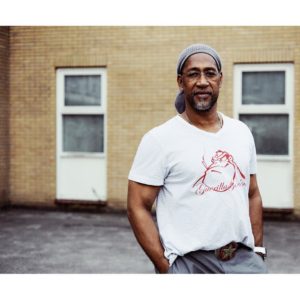
Kool DJ Herc
It’s 1973 in The Bronx, New York. Kool Herc is extending breaks (the funkiest drum parts of records) to keep the dancers moving. He gets on the mic to entertain the crowd. Early hip-hop and sound system culture have much in common.
American kids dug into their parents’ record collections for hip-hop’s building blocks. British kids did the same with Jamaican music and sound systems to create much of the country’s musical innovations.
The U.K. and America had by then long been engaged in a game of transatlantic musical ping pong. From the 1970s onwards, the table they played on increasingly began to resemble a sound system.
It’s 1987 in West London. British sound systems Soul II Soul and The Wild Bunch (part of which would later become the group Massive Attack) battle it out on New Year’s Eve, in the same spirit as the sound system battles that entertained Jamaicans in Kingston. Like their American hip-hop counterparts, in the space of a decade they would go from the streets to the charts.
Someone put the echo on, and it was heard around the world.
Words, Sound and Power
Actually, let’s pause the record for a minute. Words have power, and the rewind has the widest lexicon.
The bulk of it is descriptive: Rewind, haul and pull, pull up that. Physical actions. The turntable is like a wheel, so wheel it up rudeboy! Wheel and come again. Wheel and deal it. Rewind in a hurry and the record will spinback. Mechanics. Reload.
Confused? Just take it from the top or from the edge.
Some expressions reflect the communities’ roots. In London, MC Crazy D coined the term jack it in the 2000s. His full post-rewind line was “taters on that as we jack it.” Rewind inna Cockney rhyming slang stylee.
And I’m just scratching the surface here.
The most confusing word for rewind to the uninitiated is forward. Just as DJs are MCs in Jamaica, a forward can mean a rewind. This refers to the bodily movement in the dance when a song is so good, the audience moves from behind the speakers to the front. The bodies speak.
Spinning Back on the Wheels of Steel
“Lick wood means rewind, a gunshot means forward, you requested it so we rewind”
To anyone familiar with early 1990s hip-hop and jungle, the above sentence will ring a bell. It was heard from Funkmaster Flex’s DJ sets on Hot 97 in NYC to raves in the U.K. where it preceded the drop on “Rollidge” by DJ SS.
Its first appearance seems to be on the Main Attraction remix of Cutty Ranks’ 1991 track, “The Stopper.” Further digging led me to an online post stating the voice is that of Joseph Cotton, a famous reggae DJ. Lick wood is Jamaican patois for hitting wood, what you’d do as a sign of excitement in the dance.
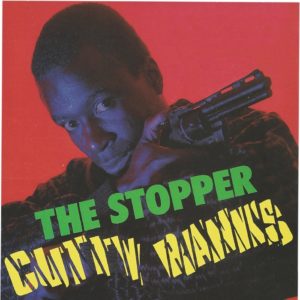
But wait, what about forward in that sentence? In this case, the forward likely refers to an actual forward, meaning a request to move on to the next track. Seen.
In hip-hop the rewind is rarely used to stop and start the track. Rather it evolved as a way to blend from one track to the next, from pause to progression. This echoes the Jamaican practice of juggling, where selectors quick mix rhythms, playing only a minute or less of each and sometimes use rewinds to progress from one to the other.
As hip-hop grew from the Bronx, the same DJs who came to perfect such mixing basics as blending and scratching would have also come to hear rewinding as a useful tool. Ultimately the rewind in hip-hop would come to have a dual usage: as a mixing trick and as a sound effect, echoing another Jamaican sonic immigrant, the air horn.
There are traces of the rewind all over hip-hop’s first decade as a popular music. It’s how Original Concept’s 1986 “Pump That Bass” starts. It’s in between loops of Bob James’ infamous cowbell and throughout Mantronix’s “King of the Beats,” a song with its own peculiar echo, as we’ll hear.
King of the Beats in the Dancehall
Back in Jamaica, dancehall was born. A sparser take on reggae, it would blow up the dance in 1985 when King Jammy and Wayne Smith produced the first fully computerized rhythm track, the “Sleng Teng.” Recalling the night he dropped the riddim on his rival, Jammy said: “It was like a smash! It was such a new song that the whole place was in uproar — we had to play it twenty times more, for all the people bawlin’ forward.”
Another shock of the new felt around the world.
By the late 1980s, hip-hop began its first overt infatuation with dancehall and Jamaican music, epitomized by acts such as Shinehead, Special Ed and KRS-One.
In 1992, KRS releases the last Boogie Down Productions album, Sex & Violence. Its title evocative of not just America’s societal ills but also dancehall’s. The second track is “Duck Down.” Towards the end of the song, KRS shouts “rewiiiiiiiind” as the backing track wheels back. Rewinds continue to reverberate in the lyrics of hip-hop MCs for decades to come.
Hardcore, You Know the Score
Back in the U.K., the late 1980s were a perfect musical storm. (Acid) house, hip-hop and sound systems collided. The tempo sped up, breaks were added, MCs chatted and the rewind came back. This was hardcore: a style of music, and a lifestyle.
London producer Wrongtom offers a personal look back that’s aptly concise. “I think the transition from reggae to raves in the U.K. was organic, especially with places like The Four Aces [a legendary east London venue] becoming Labyrinth. The transitions from one musical style to the next were quick. Pull ups would have continued through.”
It’s 1988. An unknown London producer by the name of Lennie De Ice writes a song on a 6-track admittedly inspired by the “futuristic beats of Mantronix,” combining breaks with the “progressive feel of house music and drum machines.” It comes out in 1991 as “We Are I.E.” Jungle music has its prototype.
The song is a perfect musical summary of the era. It opens with uplifting pads, typical of acid house, followed by a rewind, used throughout as a sample. Remember what I said about “King of the Beats?”
Original Nuttahs: Telepathy and AWOL
When U.K. hardcore split up, jungle was born. Hardcore was sped up, classic breaks were chopped, and dub bass shook the chests. The shock of the new. Jungle embraced rewinds more than any other 1990s U.K. sound.
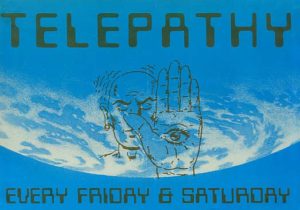
One of the earliest jungle parties in London was called Telepathy. Bret, one of the co-founders, told Brian Belle-Fortune, author of All Crews, a book about the history of jungle, that they introduced rewinds to the culture. “We both come from West Indian backgrounds. We grew up here. The reggae flavours we incorporated, things that are industry standard like rewinds—we created that at Marshgate Lane [location for the Telepathy parties in east London]. We said, ‘Tell ‘em stop the tune. Rewind it.’”
Another key early party was AWOL, held at a venue called the Paradise, where acid house and hardcore mutated into jungle. MC GQ told Belle-Fortune another story about rewind’s new home. “Randall’s mixing ability was different, on another level. You had a man come running clean from the back of the club, everyone screaming, ‘Stop the mix! Stop the mix! Rewind the whole mix.’ I don’t care what anyone says. We were the first people to rewind the whole mix.”
Shock of the new. Bawl’ forward. We pull up two tunes rudeboy.
Signal, Can I Get A Signal?
There’s one more key element in the evolution of rewinds: radio. Or to take it back to Bunny Lee, the people’s radio aka pirate radio. In the late 1980s, pirate radio moved off the boats to high rises in the poorer parts of London, just as sound systems had begun in the ghettos of Kingston.
In London, pirates were essential to dance music cultures. Raves were the location, pirate radio was the medium, and music was the message. Two distinct elements of sound system culture defined pirate radio in the British capital: the MC and the rewind.
As jungle became the sound of 1990s London pirate radio, technology allowed the rewind to tag along.
“Calling a radio station seems an odd thing to do,” Belle-Fortune remembers. “But ringing your favourite pirate to bawl for a rewind is so natural. Nothing establishes a sense of community better than regular callers.” Calling up, and later texting, for a rewind would become integral to the pirate radio experience.
Wot You Call It? Garage?
U.K. garage was born during the mid–1990s at a Sunday club called Happy Days in south London. It took the eponymous U.S. sound, sped it up, fattened the bass and stripped the diva vocals favoured by U.S. producers for a more instrumental dub approach.
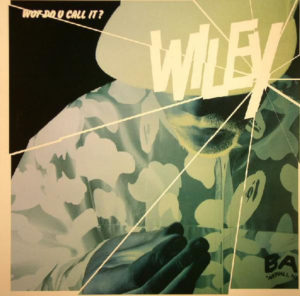
Being a London ting, U.K. garage gave a home to MCs. Journalist and dance music historian Simon Reynolds has argued that the move of MCs, many from a jungle background, to U.K. garage helped “Jamaican-ise house music.” As always, they entertained and acted as conductor between the DJ and audience when it was time to pull up and come again.
In the space of a few years, U.K. garage would evolve into speed garage—faster, harder, stronger—and ultimately 2step, a backlash against the speed and four-to-the-floor rhythms. 2step was jittery, skipping instead of pounding. It found a natural home on pirate radio.
The importance of rewinds in U.K. garage, especially 2step, is best summarized by a 1999 song from The Artful Dodger and Craig David. In its lyrics, its title and the music itself, the song is a tribute to the rewind. “Re-Rewind (The Crowd Say Bo Selecta)” reached number two in the U.K. charts.
By the turn of the century, the rewind is still there, hidden in plain sight. From Nas’ “Blaze a 50” to Beverley Knight’s self-help guide “Rewind (Find A Way)” via Cylob’s “Rewind,” a bonkers Rewind For Dummies in electronic form.
Back in London, U.K. garage continues its unlikely mutation. It moves to the studio as producers go seeking another shock of the new. In comes grime and dubstep, the latest chapter of the rewind’s journey from that fateful 1968 night in Jamaica. Even if they may sound nothing alike today, the two genres are conjoined twins at birth.
Grime DJ Elijah points out that rewinds are part of his DNA as a Jamaican youth growing up in London. This is a common story within grime performers and fans that helps explain why the rewind became an essential part of grime’s furious energy.
I asked Elijah for a stand-out memory of rewinds. “The obvious one is Lethal B’s “Pow” track in 2004 getting a reload for every verse. It has 10. The tune needed at least 10 mins to get through all the singalongs. Certain clubs thought it would be better to ban it.”
Like Being In Love: You Just Know
In the mid 2000s, I would tune in semi-religiously to Rinse FM, London’s leading pirate radio. It was the FWD>> show with Kode9, who would run the freshest dubplates from the post–2step era and early days of both grime and dubstep.
We were hundreds of listeners all around London. And we only had to do one thing to get what we want. “10 gets you a rewind.” “I want to see ten missed calls.” Pirate radio builds its community through its regular listeners.
The early days of dubstep in London also gave us one of the most democratic public uses of the rewind in U.K. history.
It’s 2005 in Brixton, South London. A club called Third Base, located inside an old church, near the center of Brixton, began hosting a new bi-monthly party called DMZ. Inside the club the set up was spartan, no flashy lights or smoke machines. Just a finely tuned sound system, bags of dub plates and bodies in the dance.
The turntables were situated at audience level. As such, anyone could bawl’ forward and request or, as happened, stop the record and call the rewind themselves. As with the early days of jungle, the rewind was a way for dubstep audiences to participate in the moment.
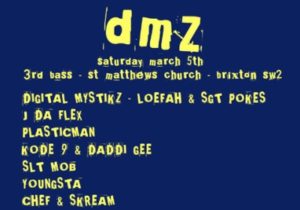
Early DMZ flyer
Founded by London producers Digital Mystikz and Loefah, and inspired by sound system culture and the heydays of jungle, DMZ was both a spiritual and physical experience. This was epitomised by its flyers’ tagline: “Come meditate on bass weight.”
DMZ inevitably grew past its humble beginnings and moved upstairs to a bigger venue within the same building. The decks were no longer easy to reach but some were lucky enough to still be in close range to make the call when the time was right.
One of those was Martin Clark. In July 2006, he recounted the importance of such an action. “Rewinding shouldn’t be taken lightly… The tune has to be so unfeasibly amazing that you [cannot] control yourself. There’s no decision to cognitively be made, the answer is self-evident. Like being in love: you just know.”
One Last Echo
Two other early attendees of dubstep’s foundational years in London were U.S. DJs Joe Nice from Baltimore and Dave Q from NYC, who would go on to found America’s answer to DMZ, Dub War. At the time, Joe had a radio show called Gourmet Beats, airing online. It soon became the definitive U.S. dubstep broadcast.
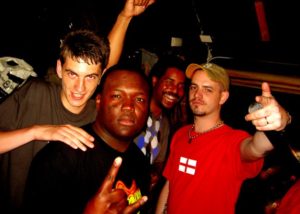
Dub War crew and Skream
Sometime between 2005 and 2006, the pair flipped London’s pirate radio request line. “I don’t remember what tune I was playing,” Joe recalls, “but the chatroom was going crazy, and I said, ‘I need 5 for the reload’ expecting to see the word five times in the chat.” Instead, Dave Q went straight for the number. “I just put in a ‘5’ and that was an instant rewind. It became the thing that you just write ‘5’ if you want a pull up.”
Back in London, it’s DMZ’s first birthday bash. Joe Nice is standing behind the turntables with arms outstretched, hands signalling five. The audience reciprocates. The Americans’ twist on the standard U.K. radio request makes it back across the Atlantic. I swear I once saw someone bring a piece of paper to DMZ with the number 5 written on it and hold it up.
No Rewinds Please, We’re American
It’s worth noting at this point that of all the primary dance music genres, house and techno are the only two—especially in America—to make no use of rewinds as a performing practice. Starting with the music’s roots in disco all the way to the early warehouse parties, house and techno are about a continuous experience that led you to spiritual, and sometimes physical, ecstasy. Something as harsh as the rewind found no place in the music or culture.
Thirty years later, America is in the thrall of an EDM boom. A new generation of kids seeking new experiences amid the visual and auditory overloads of stadium-sized shows. There are no rewinds.
A Truly Democratic Musical Practice
So after forty years of rewinding tunes, one thing is for sure: the rewind is the most democratic musical practice of modern times: it ensures no one, audience or DJ, is above anyone else. It also has a bad rep for being abused, the tool of coked-up MCs disconnected from the crowd. Sort of like politics today. Like I said, democratic.
As unlikely as it is, should the rewind’s instrument, the turntable, disappear, we may become unable to bawl’ forward. And while I’ve yet to find a plug-in to automatically generate rewinds in live performance software like Ableton, I know a few modern performers who make it happen on their live rigs.
Elijah imagines the rewind being “like a great guitar solo or something in rock music.” Joe Nice sums up the necessary cues for a perfect rewind as “reading the crowd, mood, and timing.”
The last word goes to John Eden, who brings it back to the people. “The key thing is: sound systems are supposed to be part of a community… so it’s a two-way thing, a conversation rather than a monologue.”
